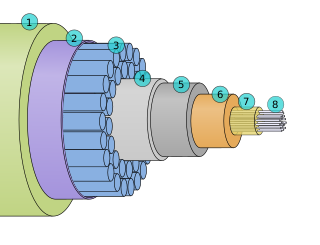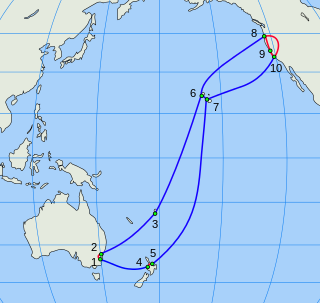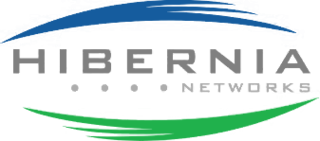Related Research Articles

Alaska is a non-contiguous U.S. state on the northwest extremity of North America. It borders the Canadian province of British Columbia and the Yukon territory to the east; it shares a western maritime border in the Bering Strait with Russia's Chukotka Autonomous Okrug. The Chukchi and Beaufort Seas of the Arctic Ocean lie to the north and the Pacific Ocean lies to the south. Technically a semi-exclave of the U.S., it is the largest exclave in the world.

A submarine communications cable is a cable laid on the seabed between land-based stations to carry telecommunication signals across stretches of ocean and sea. The first submarine communications cables were laid beginning in the 1850s and carried telegraphy traffic, establishing the first instant telecommunications links between continents, such as the first transatlantic telegraph cable which became operational on 16 August 1858.

The Alaska Time Zone observes standard time by subtracting nine hours from Coordinated Universal Time (UTC−09:00). During daylight saving time its time offset is eight hours (UTC−08:00). The clock time in this zone is based on mean solar time at the 135th meridian west of the Greenwich Observatory.

The Southern Cross Cable is a trans-Pacific network of telecommunications cables commissioned in 2000. The network is operated by the Bermuda-registered company Southern Cross Cables Limited. The network has 28,900 km (18,000 mi) of submarine and 1,600 km (990 mi) of terrestrial fiber optic cables, all which operate in a triple-ring configuration. Initially, each cable had a bandwidth capacity of 120 gigabit/s. Southern Cross offers capacity services from 100M/STM-1 to 100 Gbit/s OTU-4, including 1G, 10G and 40G Ethernet Private Line services.

A cable layer or cable ship is a deep-sea vessel designed and used to lay underwater cables for telecommunications, for electric power transmission, military, or other purposes. Cable ships are distinguished by large cable sheaves for guiding cable over bow or stern or both. Bow sheaves, some very large, were characteristic of all cable ships in the past, but newer ships are tending toward having stern sheaves only, as seen in the photo of CS Cable Innovator at the Port of Astoria on this page. The names of cable ships are often preceded by "C.S." as in CS Long Lines.

GCI Communication Corp (GCI) is a telecommunications corporation operating in Alaska. Through its own facilities and agreements with other providers, GCI provides cable television service, Internet access, wireline (networking), and cellular telephone service. It is a subsidiary of Colorado-based company Liberty Broadband, a company affiliated with Liberty Media that also owns a 26% interest in Charter Communications, having been originally acquired by Liberty in 2015.

Hibernia Networks, alternately known as Hibernia Atlantic, was a privately held, US-owned provider of telecommunication services. It operated global network routes on self-healing rings in North America, Europe and Asia including submarine communications cable systems in the North Atlantic Ocean which connected Canada, the United States, the Republic of Ireland, the United Kingdom and mainland Europe. Hibernia managed cable landing stations in Dublin, Republic of Ireland; Coleraine, Northern Ireland; Southport, England; Halifax, Canada; Lynn, Massachusetts, United States.
Alaska Communications is a telecommunications corporation headquartered in Anchorage, Alaska. It was the first telecommunications provider in the state of Alaska to maintain a third-generation wireless network and the only provider in Alaska that owned fully incorporated infrastructure for the major telecommunications platforms; wireless communications, Internet networking, and local and long-distance phone service. Alaska Communications wireline operations include advanced data networks and an underwater fiber optic system. The Alaska Communications wireless operations included a statewide 3G CDMA network, and coverage extended from the North Slope to Southeast Alaska.

KTUU-TV is a television station in Anchorage, Alaska, United States, affiliated with NBC and CBS. It is owned by Gray Television alongside MyNetworkTV affiliate KAUU. The two stations share studios on East 40th Avenue in midtown Anchorage; KTUU-TV's transmitter is located in Knik, Alaska.
SEA-ME-WE3 or South-East Asia - Middle East - Western Europe 3 is an optical submarine telecommunications cable linking those regions and is the longest in the world. Completed in late 2000, it is led by France Telecom and China Telecom, and is administered by Singtel, a telecommunications operator owned by the Government of Singapore. The Consortium is formed by 92 other investors from the telecom industry. It was commissioned in March 2000.

South East Asia–Middle East–Western Europe 4 is an optical fibre submarine communications cable system that carries telecommunications between Singapore, Malaysia, Thailand, Bangladesh, India, Sri Lanka, Pakistan, United Arab Emirates, Saudi Arabia, Egypt, Italy, Tunisia, Algeria and France. It is intended to be a complement to, rather than a replacement for, the SEA-ME-WE 3 cable.

MedNautilus is a submarine telecommunications cable system linking countries bordering the Eastern/Central Mediterranean Sea. It is a successor of the LEV system linking Cyprus, Israel and Italy.

NPC is a submarine telecommunications cable system in the North Pacific Ocean linking the United States and Japan.
KATH-LD, virtual channel 2, is a low-power NBC-affiliated television station licensed to both Juneau and Douglas, Alaska, United States. The station is owned by Gray Television. KATH-LD's transmitter is located in downtown Juneau.

Pangea is a submarine telecommunications cable system transiting the North Sea connecting UK with Denmark and Netherlands. By 2002, it was no longer in service. It consisted of two widely separated submarine segments - Pangea North and Pangea South.
Unity is a Trans-Pacific submarine communications cable between Japan and the United States that was completed in April 2010.
The 2014 Palma Bay earthquake occurred at 02:54 Alaska Daylight Time on July 25 in the northern southeastern panhandle of the U.S. state of Alaska. The earthquake registered 6.0 on the moment magnitude scale and had a maximum Mercalli intensity of IV (Light). It was centered on Palma Bay, 26 miles (42 km) from Elfin Cove and 94 miles (151 km) from the state capital of Juneau. Although there were no injuries or deaths, there were significant disruptions to Internet and telecommunications throughout Southeast Alaska, including to major telecom providers Alaska Communications Systems (ACS) and AT&T wireless, Internet and other communication systems.
Hibernia Express is a submarine communications cable system which was privately owned by Hibernia Networks linking Canada, Ireland, and the UK. Hibernia Express is now owned by telecommunications provider GTT Communications, Inc. after their acquisition of Hibernia Networks. At 58.95ms of latency, the cable is currently the lowest latency fiber optic route between the NY4 data center in Secaucus, New Jersey and London.
Far North Fiber, also called Far North Fiber Express Route, is a proposed 14,000 km long submarine fiber-optic cable connecting Japan and Europe by traversing the Northwest Passage. The cable was proposed in December, 2021 by Finnish company Cinia and Far North Digital of Anchorage, Alaska.
References
- ↑ Alaska United East, Fiber Atlantic, retrieved 2018-02-09
- ↑ Cable locations, Oregon Fishermen's Cable Committee, retrieved 2018-02-09
- ↑ "Submarine Cable Landing Directory", telegeography.com, archived from the original on 2014-11-09, retrieved 2018-02-09
- ↑ System FAQ, Alaska United, retrieved 2018-02-09
- ↑ Laying of Under Sea Fiber Optic Cable Scheduled to Commence August 5, 1998, CGI, July 16, 1998
- ↑ Will Swagel (August 1, 1997), "Bandwidth comes to Alaska", Alaska Business Monthly, archived from the original on February 10, 2018
- ↑ GCI ship to repair earthquake-damaged fiber optic cables, Wrangell, Alaska: KSTK, January 11, 2013